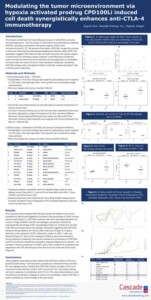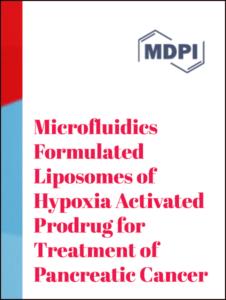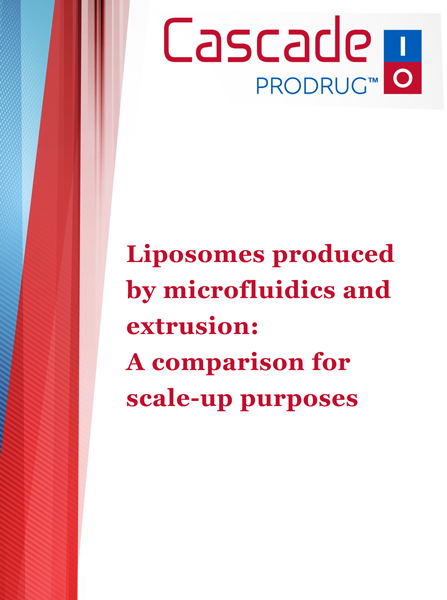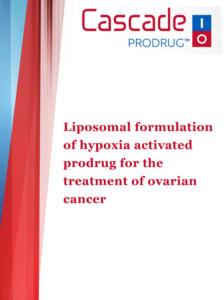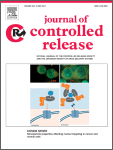Abstract
Background
The industry is diverting from chemotherapy because of side-effects, primarily immunosuppressive – but not so fast, it could hold immunostimulatory properties. CPD100, a prodrug, is activated in the hypoxic regions of the tumor microenvironment. The liposome formulation, CPD100Li, targets the prodrug to the tumor following the enhanced permeability and retention effect (EPR). Our hypothesis suggests that indiscriminate cell death induced in the hypoxic regions of solid tumors by activating a potent cytotoxin could effectively remodel the tumor microenvironment from tumor directed immunosuppression to modulated immunity under the control of one or more checkpoint molecules. Combining CPD100Li therapy with a checkpoint inhibitor could then unleash activated T cells to kill the cancer selectively.
Methods
Subcutaneous CT26 murine colon carcinoma in female BALB/c mice were assessed for the effects of CPD100Li on the immunophenotype of implanted tumors compared to Vehicle by multiparametric flow cytometry. Additional treatment groups included three anti-checkpoint inhibitors mCTLA-4, mPD-L1 and mVISTA, alone and in combinations with CPD100Li to assess anti-cancer effects compared to isotype control.
Results
Flow cytometry demonstrated CPD100Li decreased cell viability in the tumors compared to Vehicle and triggered an increase in the percentage of CD45+ among total live cells (figure 1). CPD100Li treatment also led to decreased absolute cell counts of Tregs, M-MDSC and M2 macrophages, compared to Vehicle but maintained the percentage of M1 macrophages (figure 2). Furthermore, the ratio of M1/M2 tumor-associated macrophages increased, suggesting that CPD100Li enhances the persistence of immune cells in the tumor (figure 3). Finally, a reduction in the expression of PD-1 exhaustion marker on CD8+ T cells was observed (figure 4). None of the checkpoint inhibitors alone demonstrated a strong response to delaying tumor growth whereas the combination of CPD100Li and CTLA-4 showed a significant synergistic response delaying tumor growth – an increase in time to progression of >200%, and a >60% incidence of complete tumor regressions with 25% remaining as tumor-free survivors at the end of the study (figure 5).
Conclusions
Taken together, these data provide evidence that CPD100 inhibits CT26 tumor growth by attenuating T cell exhaustion, possibly by a mechanism that promotes M1 macrophage activity. Feasibly, that CPD100Li induces changes in the tumor microenvironment that can convert ‘cold’ tumors into ‘hot’, promoting a strong anti-tumor response in combination with CTLA-4. This study demonstrates a novel and effective combination strategy for cancer immunotherapy, making it a potent candidate for cancer therapy in near future.
Vidhi M. Shah 1,2,3, Craig Dorrell 2, Adel Al-Fatease 1,3, Brittany L. Allen-Petersen 4, Yeonhee Woo 1, Yuliya Bortnyak 1, Rohi Gheewala 5, Brett C. Sheppard 2,6,7, Rosalie C. Sears 2,4,7, and Adam WG. Alani 1,7,8
Abstract: Pancreatic ductal adenocarcinoma (PDAC) presents as an unmet clinical challenge for drug delivery due to its unique hypoxic biology. Vinblastine-N-Oxide (CPD100) is a hypoxia-activated prodrug (HAP) that selectively converts to its parent compound, vinblastine, a potent cytotoxic agent, under oxygen gradient. The study evaluates the efficacy of microfluidics formulated liposomal CPD100 (CPD100Li) in PDAC. CPD100Li were formulated with a size of 95 nm and a polydispersity index of 0.2. CPD100Li was stable for a period of 18 months when freeze-dried at a concentration of 3.55 mg/mL. CPD100 and CPD100Li confirmed selective activation at low oxygen levels in pancreatic cancer cell lines. Moreover, in 3D spheroids, CPD100Li displayed higher penetration and disruption compared to CPD100. In patient-derived 3D organoids, CPD100Li exhibited higher cell inhibition in the organoids that displayed higher expression of hypoxia-inducible factor 1 alpha (HIF1A) compared to CPD100. In the orthotopic model, the combination of CPD100Li with gemcitabine (GEM) (standard of care for PDAC) showed higher efficacy than CPD100Li alone for a period of 90 days. In summary, the evaluation of CPD100Li in multiple cellular models provides a strong foundation for its clinical application in PDAC.
- Department of Pharmaceutical Sciences, College of Pharmacy, Oregon State University, 2730 South Moody Avenue, Portland, OR 97201, USA; shahv@ohsu.edu (V.M.S.); afatease@kku.edu.sa (A.A.-F.); rosalynn.woo@gmail.com (Y.W.); bortnyak.yuliya@gmail.com (Y.B.)
- Brenden-Colson Center for Pancreatic Care, Oregon Health and Science University, 3181 Southwest Sam Jackson Park Road, Portland, OR 97239, USA; dorrellc@ohsu.edu (C.D.); sheppard@ohsu.edu (B.C.S.); searsr@ohsu.edu (R.C.S.)
- Department of Pharmaceutics, College of Pharmacy, King Khalid University, Guraiger, Abha 62529, Saudi Arabia
- Department of Molecular and Medical Genetics, Oregon Health and Science University, 3181 Southwest Sam Jackson Park Road, Portland, OR 97239, USA; ballenpe@purdue.edu
- School of Medicine, Oregon Health & Science University, 3181 Southwest Sam Jackson Road, Portland, OR 97239, USA; gheewala@ohsu.edu
- Department of Surgery, Oregon Health and Science University, 3181 Southwest Sam Jackson Park Road, Portland, OR 97239, USA
- Knight Cancer Institute, Oregon Health & Science University, Portland, OR 97120, USA
- Department of Biomedical Engineering, School of Medicine at Oregon Health & Science University, Portland, OR 97239, USA
* Correspondence: Adam.Alani@oregonstate.edu
Shah VM, Nguyen DX, Alfatease A, Bracha S, Alani AW.
Solid tumors often contain hypoxic regions which are resistant to standard chemotherapy and radiotherapy. We have developed a liposomal delivery system for a prodrug of vinblastine (CPD100) which converts to the parent compound only in the presence of lower oxygen levels. As a part of this work we have developed and optimized two formulations of CPD100: one composed of sphingomyelin/cholesterol (55/45; mol/mol) (CPD100Li) and the other composed of sphingomyelin/cholesterol/PEG (55/40/5; mol/mol) (CPD100 PEGLi). We evaluated the antiproliferative effect of CPD100 and the two formulations against A549 non-small lung cancer cell. A549 cell line showed to be sensitive to CPD100 and the two formulations displayed a higher hypoxic: air cytotoxicity ratio compared to the pro-drug. CPD100 elimination from the circulation after injection in mouse was characterized by a very short circulation time (~0.44h), lower area under the curve (AUC) (33μgh/mL) and high clearance (916mL/h/kg) and lower volume of distribution (17.4mL/kg).Total drug elimination from the circulation after the administration of liposomal formulation was characterized by prolonged circulation time (5.5h) along with increase in the AUC (56μgh/mL) for CPD100 Li and (9.5h) with AUC (170μgh/mL) for CPD100PEGLi. This was observed along with increase in volume of distribution and decrease in clearance for the liposomes. The systemic exposure of the free drug was much lower than that achieved with the liposomes. When evaluated for the efficacy in A549 xenograft model in mice, both the liposomes demonstrated excellent tumor suppression and reduction for 3months. The blood chemistry panel and the comprehensive blood analysis showed no increase or decrease in the markers and blood count. In summary, the pharmacokinetic analysis along with the efficacy data emphasis on how the delivery vehicle modifies and enhances the accumulation of the drug and at the same time the increased systemic exposure is not related to toxicity…
Vidhi M Shah, Duc X Nguyen, Adel Al Fatease, Pragnesh Patel, Brianna Cote, Yeonhee Woo, Rohi Gheewala, Yvonne Pham, Man Gia Huynh, Christen Gannett, Deepa A Rao, Adam W G Alani
Abstract: In this work, a new sphingomyelin-cholesterol liposomal formulation (CPD100Li) for the delivery of a hypoxia activated prodrug of vinblastine, mon-N-oxide (CPD100), is developed. The optimized liposomal formulation uses an ionophore (A23187) mediated pH-gradient method. Optimized CPD100Li is characterized for size, drug loading, and stability. The in vitro toxicity of CPD100Li is assessed on different aspects of cell proliferation and apoptosis of ES2 ovarian cancer under normoxic and hypoxic conditions. The pharmacokinetics of CPD100Li in mice as well as the influence of A23187 on the retention of CPD100 are assessed. The dose limiting toxicity (DLT) and maximum tolerated dose (MTD) for CPD100Li are evaluated in nude mice. CPD100 is loaded in the liposome at 5.5 mg/mL. The sizes of CPD100Li using DLS, qNano and cryo-TEM techniques are 155.4 ± 4.2 nm, 132 nm, and 112.6 ± 19.8 nm, respectively. There is no difference between the in vitro characterization of CPD100Li with and without ionophore. Freshly prepared CPD100Li with ionophore are stable for 48 h at 4 °C, while the freeze-dried formulation is stable for 3 months under argon at 4 °C. The hypoxic cytotoxicity ratios (HCR) of CPD100 and CPD100Li are 0.16 and 0.11, respectively. CPD100Li under hypoxic conditions has a 9.2-fold lower IC50 value as compared to CPD100Li under normoxic conditions, confirming the hypoxia dependent activation of CPD100. CPD100Li treated ES2 cells show a time dependent enhanced cell death, along with caspase production and an increase in the number of cells in G0/G1 and higher cell arrest. The blood concentration profile of CPD100Li in mice without A23187 has a 12.6-fold lower area under the curve (AUC) and 1.6-fold lower circulation time compared to the CPD100Li with A23187. The DLT for both CPD100 and CPD100Li is 45 mg/kg and the MTD is 40 mg/kg in nude mice. Based on the preliminary data obtained, we clearly show that the presence of ionophore affects the in vivo stability of CPD100. CPD100Li presents a unique opportunity to develop a first-in-kind chemotherapy product based on achieving selective drug activation through the hypoxic physiologic microenvironment of solid tumors.
Shah VM, Nguyen DX, Alfatease A, Bracha S, Alani AW.
Solid tumors often contain hypoxic regions which are resistant to standard chemotherapy and radiotherapy. We have developed a liposomal delivery system for a prodrug of vinblastine (CPD100) which converts to the parent compound only in the presence of lower oxygen levels. As a part of this work we have developed and optimized two formulations of CPD100: one composed of sphingomyelin/cholesterol (55/45; mol/mol) (CPD100Li) and the other composed of sphingomyelin/cholesterol/PEG (55/40/5; mol/mol) (CPD100 PEGLi). We evaluated the antiproliferative effect of CPD100 and the two formulations against A549 non-small lung cancer cell. A549 cell line showed to be sensitive to CPD100 and the two formulations displayed a higher hypoxic: air cytotoxicity ratio compared to the pro-drug. CPD100 elimination from the circulation after injection in mouse was characterized by a very short circulation time (~0.44h), lower area under the curve (AUC) (33μgh/mL) and high clearance (916mL/h/kg) and lower volume of distribution (17.4mL/kg).Total drug elimination from the circulation after the administration of liposomal formulation was characterized by prolonged circulation time (5.5h) along with increase in the AUC (56μgh/mL) for CPD100 Li and (9.5h) with AUC (170μgh/mL) for CPD100PEGLi. This was observed along with increase in volume of distribution and decrease in clearance for the liposomes. The systemic exposure of the free drug was much lower than that achieved with the liposomes. When evaluated for the efficacy in A549 xenograft model in mice, both the liposomes demonstrated excellent tumor suppression and reduction for 3months. The blood chemistry panel and the comprehensive blood analysis showed no increase or decrease in the markers and blood count. In summary, the pharmacokinetic analysis along with the efficacy data emphasis on how the delivery vehicle modifies and enhances the accumulation of the drug and at the same time the increased systemic exposure is not related to toxicity…



